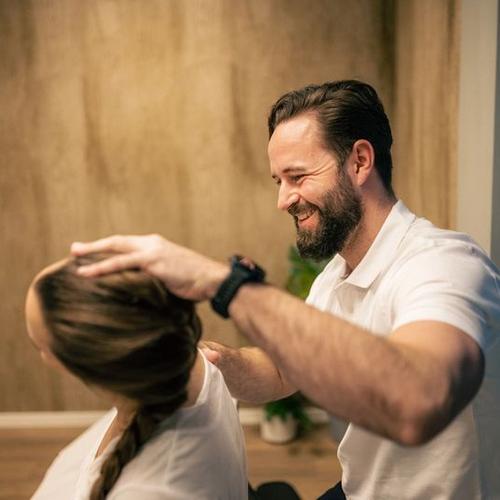Neck kink
A kink in the neck is an uncomfortable condition that can occur suddenly. This can happen due to improper head or neck positioning, muscle tension, or sudden movements that overextend the neck. Symptoms include neck pain, limited mobility, and stiffness. A kink in the neck can also lead to headaches and discomfort in the shoulders or arms. Treatment may involve rest, exercises, chiropractic adjustments, and massage, depending on the severity of the condition. It is important to take neck problems seriously and seek advice from healthcare professionals in case of persistent pain.
See availability
What are you looking for?
Symptoms of neck kink
The following symptoms may indicate that you have a kink in the neck:
- Neck pain, often concentrated on one side of the neck.
- Limited range of motion that makes it difficult to turn your head.
- Stiffness in the neck and neck muscles.
- Sharp or aching pains when you move your head or neck, especially when tilting it to the side or rotating it.
A kink in the neck can occur suddenly due to factors like improper sleeping position, sudden movements, or muscle strain. It is important to seek professional guidance for an accurate diagnosis and proper treatment if you experience these symptoms.
See availability
Treatment
Treatment for a neck kink often involves various approaches to achieve specific treatment goals. Here are some common treatment methods:
- Pain Relief: Through manual techniques such as massage, chiropractic adjustments, and trigger point therapy, neck pain can be reduced.
- Improved Mobility: Specific stretching exercises and techniques can help improve neck mobility and loosen neck muscles.
- Strength Training: Gradually introducing strength exercises for the neck and shoulder muscles can help reduce tension and improve posture.
- Ergonomic Adjustment: Evaluating the workstation and adjusting seating position and monitor height can help prevent future neck problems.
- Functional Rehabilitation: Gradually resume daily activities, with a focus on restoring normal neck function.
It's important to understand that treatment for a neck kink should be tailored to individual needs and may vary from person to person. A thorough assessment and close collaboration with an experienced physical therapist or chiropractor are crucial for developing an effective treatment plan.
When should you book an appointment?
If you recognize the symptoms above and are experiencing any of the following issues, we recommend seeking professional guidance:
- Pain or reduced mobility that has persisted for more than a week without improvement.
- Severe symptoms that you need assistance in reducing quickly.
- Symptoms that cause you concern or that you believe may be due to more serious conditions.
Remember that early assistance from a therapist can reduce the duration of your issues and contribute to achieving the best possible outcome. You should never worry that your problems are "too small" - we take all types of issues seriously.
See availability
Find clinic and therapist

Find therapist
Find a therapist that suits you and your needs by filtering on one or more criteria.

Telephone
Authorized healthcare personnel assist you over the phone. We answer the phone within 60 seconds. Free of charge.
Use your health insurance
We cooperate with all the major insurance companies, so that you can use your health insurance with us if you have foot pain or other problems.
Read more about how to use your health insurance here
What can you do by yourself?
While treatment for a neck kink typically involves professional guidance and therapy, there are several steps you can take on your own to alleviate symptoms and improve the condition:
- Follow recommended exercises: If you have been prescribed exercises by your therapist, it is essential to perform them regularly.
- Continue to stay active: Do not completely cease activities that involve neck movements. If you can perform short movements without pain, this is usually acceptable.
- Pain relief: Occasionally, pain can be alleviated by using ice packs, heat pads, a warm shower, or gentle movements.
- Medications: Use over-the-counter pain relievers as directed by healthcare professionals.
- Adjust activities: Avoid activities that lead to prolonged worsening of neck pain (more than 12 hours).
- Maintain good communication with your therapist: So that the treatment plan can be adjusted to any changes you experience.
If you have not yet had your condition assessed or have deviated from the treatment plan, it is recommended to contact healthcare professionals for further guidance.
See availabilityFrequently asked questions about crick in the neck
What is a kink in the neck?
A kink in the neck refers to a sudden discomfort or pain in the neck, typically caused by improper neck positioning, muscle tension, or abrupt movements.
What is a kink in the neck?
A kink in the neck refers to a sudden discomfort or pain in the neck, typically caused by improper neck positioning, muscle tension, or abrupt movements.
What are the most common causes of a kink in the neck?
The most common causes of a kink in the neck include improper sleeping posture, sudden movements, and muscle strain.
What are the most common causes of a kink in the neck?
The most common causes of a kink in the neck include improper sleeping posture, sudden movements, and muscle strain.
What are the typical symptoms of a kink in the neck?
Typical symptoms of a kink in the neck include neck pain, limited range of motion, stiffness in the neck and shoulders, as well as sharp or aching pains with movement.
What are the typical symptoms of a kink in the neck?
Typical symptoms of a kink in the neck include neck pain, limited range of motion, stiffness in the neck and shoulders, as well as sharp or aching pains with movement.
How can I relieve the pain from a kink in the neck at home?
You can try to relieve the pain at home by using an ice pack, heat pad, performing gentle stretching exercises, and avoiding activities that worsen the pain.
How can I relieve the pain from a kink in the neck at home?
You can try to relieve the pain at home by using an ice pack, heat pad, performing gentle stretching exercises, and avoiding activities that worsen the pain.
When should I seek medical help for a kink in the neck?
You should seek medical help if the pain persists for more than a week, if you experience severe symptoms, or if you are concerned about your condition.
When should I seek medical help for a kink in the neck?
You should seek medical help if the pain persists for more than a week, if you experience severe symptoms, or if you are concerned about your condition.